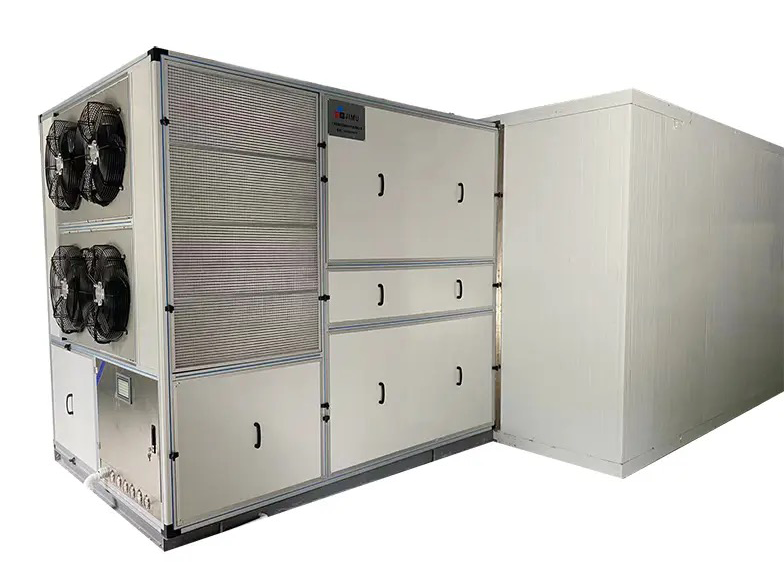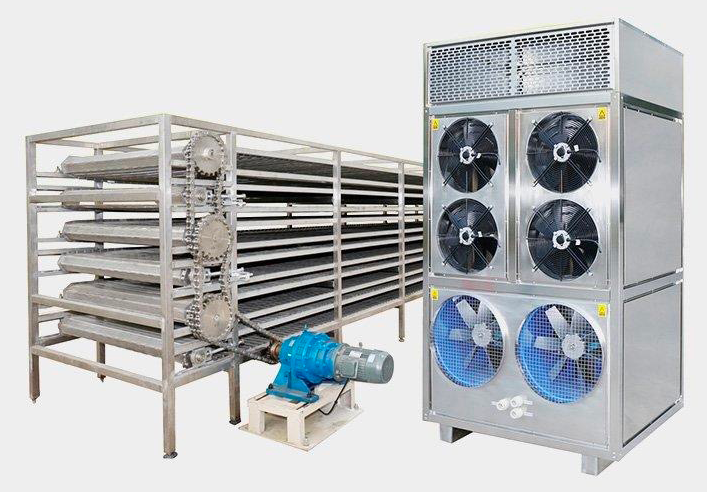
Content Menu
● Understanding Food Dehydration
● Types of Food Drying Machines
● Heat Pump Dryers: An In-Depth Look
>> Mechanism of Action
>> Advantages
>> Applications
>> Limitations
● Condenser Dryers: An In-Depth Look
>> Mechanism of Action
>> Advantages
>> Applications
>> Limitations
● Comparative Analysis of Heat Pump vs. Condenser Dryers
● Choosing the Right Dryer for Your Needs
● The Future of Food Drying Technologies
>> Sustainability Considerations
● Real-world Applications
● Conclusion
● FAQ
>> 1. What is a food dehydrator?
>> 2. How does a heat pump dryer work?
>> 3. What types of foods can be dried using these machines?
>> 4. Are there any health benefits associated with dehydrated foods?
>> 5. How do I maintain my food dehydrator?
● Citations:
Food dehydration is an essential process in the food industry, allowing for the preservation and enhancement of various food products. As a manufacturer of food drying machines, understanding the nuances between different drying technologies, such as heat pump dryers and condenser dryers, is vital for optimizing production and meeting market demands. This article will explore the differences between these two types of dryers, their mechanisms, advantages, and applications in food processing.

Understanding Food Dehydration
Food dehydration is the process of removing moisture from food to inhibit spoilage and extend shelf life. This method has been used for centuries and is crucial in preserving fruits, vegetables, meats, and herbs. Modern food dehydrators utilize advanced technology to ensure efficient moisture removal while maintaining the nutritional quality of the food.
Types of Food Drying Machines
1. Heat Pump Dryers
- Utilizes a refrigeration cycle to extract moisture.
- Operates at lower temperatures, preserving nutrients.
- Highly energy-efficient due to recycling heat.
- Ideal for sensitive products that require gentle drying.
2. Condenser Dryers
- Uses direct heat to evaporate moisture.
- Generally operates at higher temperatures.
- More suited for robust products that can withstand intense heat.
- Often used in commercial settings for bulk drying.
Heat Pump Dryers: An In-Depth Look
Heat pump dryers are increasingly popular in food processing due to their energy efficiency and ability to operate at lower temperatures. They work by extracting moisture from the air inside the drying chamber using a refrigerant cycle.
Mechanism of Action
- Evaporation: The heat pump draws in humid air from the drying chamber.
- Condensation: The moisture is condensed into water droplets, which are then removed.
- Recycling Heat: The heat generated during condensation is recycled back into the drying chamber, reducing energy consumption.
Advantages
- Nutrient Preservation: Lower operating temperatures help retain vitamins and minerals in food products.
- Energy Efficiency: By recycling heat, these dryers consume significantly less energy compared to traditional methods.
- Versatility: Suitable for a wide range of products, including fruits, vegetables, and even delicate herbs.
Applications
- Ideal for small-scale operations and artisanal producers looking to maintain high-quality standards in their dried products.
Limitations
Despite their advantages, heat pump dryers may have some limitations:
- Initial Investment: The upfront cost of heat pump dryers can be higher than that of condenser dryers due to their advanced technology.
- Drying Time: While they are energy-efficient, they may take longer to dry certain products compared to high-temperature methods.

Condenser Dryers: An In-Depth Look
Condenser dryers are more traditional drying machines that use direct heat to evaporate moisture from food products. They are widely used in commercial settings due to their high throughput capabilities.
Mechanism of Action
- Heating Element: The dryer uses electric or gas heating elements to raise the temperature inside the chamber.
- Moisture Removal: As the temperature increases, moisture evaporates from the food surfaces and is expelled from the chamber.
Advantages
- High Capacity: Can handle large volumes of product at once, making them suitable for industrial applications.
- Speed: Faster drying times due to higher operating temperatures.
Applications
- Commonly used in large-scale food production facilities where speed and volume are critical factors.
Limitations
Condenser dryers also come with their own set of limitations:
- Nutrient Loss: The higher temperatures can lead to degradation of some vitamins and minerals in sensitive foods.
- Energy Consumption: These dryers may consume more energy overall compared to heat pump dryers since they do not recycle heat.
Comparative Analysis of Heat Pump vs. Condenser Dryers
| Feature | Heat Pump Dryer | Condenser Dryer |
| Operating Temperature | Lower temperatures (40°C - 70°C) | Higher temperatures (60°C - 90°C) |
| Energy Efficiency | High (recycles heat) | Moderate (direct heating) |
| Nutrient Preservation | Excellent (retains vitamins) | Good (some nutrient loss) |
| Moisture Removal Process | Evaporation followed by condensation | Direct evaporation |
| Ideal Products | Fruits, vegetables, herbs | Robust products like meats |
| Typical Use Cases | Small scale, artisanal production | Large scale commercial production |
Choosing the Right Dryer for Your Needs
When selecting between a heat pump dryer and a condenser dryer for your food processing needs, consider the following factors:
- Product Type: If you are working with delicate items like herbs or fruits that require gentle handling, a heat pump dryer may be more suitable. For tougher products like meats or bulk vegetables, a condenser dryer might be preferable.
- Energy Costs: Heat pump dryers tend to have higher upfront costs but lower operational costs due to their energy efficiency. Evaluate your budget and long-term savings when making a decision.
- Production Volume: For larger operations requiring high throughput, condenser dryers offer faster drying times and greater capacity. Conversely, heat pump dryers excel in smaller batch sizes where quality is paramount.
The Future of Food Drying Technologies
As technology continues to advance, both heat pump and condenser dryers are likely to see improvements that enhance their efficiency and effectiveness. Innovations such as smart sensors that monitor humidity levels in real-time could lead to more precise control over the drying process. Additionally, hybrid systems that combine features from both types of dryers may emerge, offering manufacturers greater flexibility in their operations.
Sustainability Considerations
The growing emphasis on sustainability in food production also influences dryer technology development. Heat pump dryers are inherently more sustainable due to their lower energy consumption. However, advancements in renewable energy sources could make condenser dryers more environmentally friendly as well. Manufacturers will need to consider sustainability not only in terms of energy use but also regarding the materials used in constructing these machines.
Real-world Applications
To illustrate how these technologies are applied in real-world scenarios:
1. Artisan Food Producers: Small businesses focusing on organic snacks often prefer heat pump dryers because they allow for gentle drying without compromising nutritional value. Products like dried fruits retain their vibrant colors and flavors when processed at lower temperatures.
2. Commercial Snack Manufacturers: Larger companies producing bulk snacks may utilize condenser dryers for their speed and capacity. For instance, potato chips or jerky can be efficiently dried using high-temperature methods without significant quality loss due to their robust nature.
3. Herb Producers: Farmers specializing in culinary herbs often invest in heat pump technology. This approach helps preserve essential oils that contribute to flavor profiles while ensuring that delicate herbs like basil or thyme do not lose their potency during processing.
4. Meat Processing Facilities: In contrast, meat processors often rely on condenser dryers due to their ability to handle large volumes quickly while ensuring safety through thorough moisture removal—crucial for preventing spoilage and bacterial growth.
Conclusion
In summary, both heat pump dryers and condenser dryers have unique advantages that cater to different aspects of food dehydration. Heat pump dryers are ideal for preserving nutrients while being energy efficient, making them perfect for small-scale operations focusing on quality. On the other hand, condenser dryers excel in high-capacity environments where speed is essential. Understanding these differences will help manufacturers make informed decisions based on their specific needs and goals in food processing.

FAQ
1. What is a food dehydrator?
A food dehydrator is an appliance that removes moisture from food using low heat and air circulation to preserve it for longer periods without refrigeration.
2. How does a heat pump dryer work?
A heat pump dryer uses a refrigeration cycle to extract moisture from air inside the drying chamber while recycling heat generated during condensation back into the process.
3. What types of foods can be dried using these machines?
Both types of dryers can be used for fruits, vegetables, meats, and herbs; however, heat pump dryers are better suited for delicate items due to their lower operating temperatures.
4. Are there any health benefits associated with dehydrated foods?
Yes! Dehydrated foods retain most nutrients while offering concentrated flavors without preservatives or additives commonly found in store-bought snacks.
5. How do I maintain my food dehydrator?
Regular cleaning after each use is essential; ensure all trays are washed thoroughly. Additionally, check filters or fans periodically based on manufacturer recommendations to maintain efficiency.
Citations:
[1] https://ankoretail.com/products/commercial-food-drying-machine-10-layers-food-dehydrator
[2] https://en.wikipedia.org/wiki/Food_dehydrator
[3] https://www.webstaurantstore.com/guide/741/food-dehydrators-buying-guide.html
[4] https://www.alamy.com/stock-photo/food-dehydrator.html
[5] https://www.ike.cn/video
[6] https://food-drying-machine.com/food-drying-equipment/double-door-hot-air-food-drying-oven.html
[7] https://www.thespruceeats.com/best-food-dehydrators-4077285
[8] https://etsolutions.in/10-amazing-benefits-of-electrical-food-dehydrator-machines/
[9] https://www.youtube.com/watch?v=1fP2rSLjys4
[10] https://aradmachineryco.com/article/How-to-use-a-dehydratormachine











